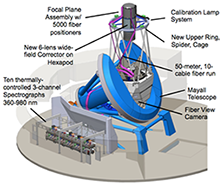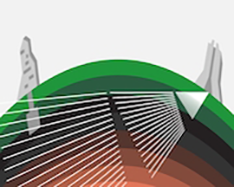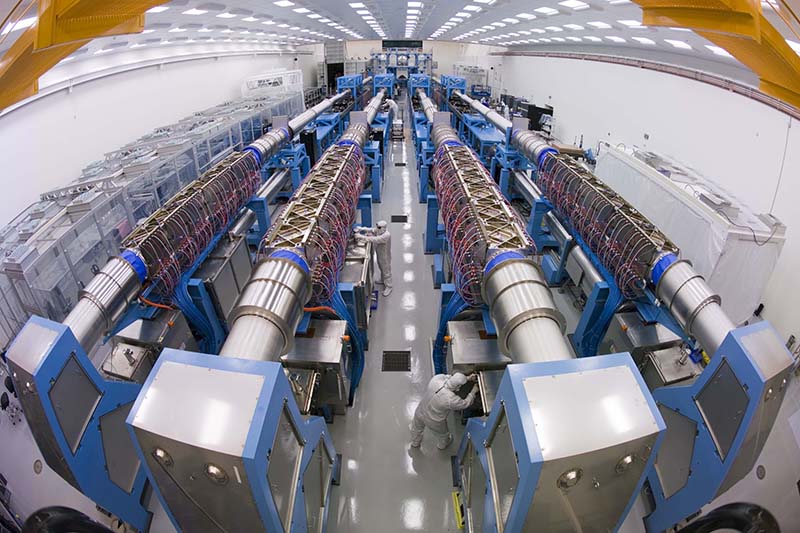Particle/Nuclear Physics and Cosmology
The department faculty currently participate in a broad range of major experiments.
|
|
RESEARCH AREA BY FACULTY
| Segev BenZvi | Cosmology and Dark Matter |
| Arie Bodek | Neutrinos and Physics at High Energy Hadron Colliders |
| Regina Demina | Cosmology and Physics at High Energy Hadron Colliders |
| Antonino Di Piazza | Quantum Electrodynamics |
| Kelly Douglass | Cosmology |
| Aran Garcia-Bellido | Physics at High Energy Hadron Colliders |
| Steven Manly | Neutrinos |
| Chris Marshall | Neutrinos |
| Kevin McFarland | Neutrinos |
| Frank Wolfs | Dark Matter |
PARTICLE ASTROPHYSICS AND COSMOLOGY
This branch of physics incorporates elements of astrophysics, particle physics, and cosmology. By observing very high energy cosmic rays, gamma rays, and neutrinos arriving at Earth, we hope to understand where these particles are accelerated and how the accelerators work. The extreme energies (> 1 TeV) and cosmologically large distances to the sources also make these particles important probes of interstellar and intergalactic space.
The Dark Energy Spectroscopic Instrument (DESI) experiment is performing dark energy measurements using baryon acoustic oscillations using data from the Mayall 4-meter telescope at Kitt Peak National Observatory (KPNO). The group is also studying the growth of large scale structure using high-throughput galaxy redshift surveys They are developing fast algorithms for the analysis of galaxy cluster statistics and the identification of voids. They study cosmic tomography using the Lyman-alpha forest and do searches for cosmologically significant transients (supernovae, kilonovae, and tidal disruption events) (Profs. BenZvi, Demina, Douglass).

The group was also involved in the search for TeV gamma rays at the High Altitude Water Cherenkov (HAWC) Gamma-ray Observatory in central Mexico (Professor BenZvi).
The LUX-Zeplin (LZ) experiment is the successor to the successful Large Underground Xenon (LUX) experiment (Professor Wolfs) located at the Sanford Underground Research Facility (SURF) in South Dakota (https://www.sanfordlab.org/). LZ is a collaboration of approximately 250 scientists, engineers and technicians from 38 institutions, including five U.S. National Labs.The Rochester effort is led by Prof. Frank Wolfs and focuses on improved background discrimination techniques, rare signal searches, and operating the electronics system.
The LZ experiment utilizes a dual-phase time projection chamber containing seven active tonnes of liquid xenon to search for dark matter interactions with baryonic matter. This central detector is housed within an ultra-pure titanium cryostat, surrounded by a liquid scintillator veto system, and the entire assembly is immersed in a 72,000-gallon tank filled with ultra-pure water to shield against background radiation.
LZ began is first science run in 2022, achieving world-leading sensitivity in the search for weakly interacting massive particles (WIMPs), the leading dark matter particle candidate. In August 2024, the collaboration announced new results from 280 days of data collection, further constraining the properties of WIMPs and setting new limits on their possible interactions. The experiment plans to continue data collection through 2028, aiming to accumulate 1,000 days of data to enhance its sensitivity and potential for discovery.

Rochester is also involved with the search for astrophysical neutrinos at the IceCube Neutrino Observatory (pictured below) at the South Pole (Professor BenZvi). Encompassing a cubic kilometer of ice, IceCube searches for nearly massless subatomic particles called neutrinos. These high-energy astronomical messengers provide information to probe the most violent astrophysical sources: events like exploding stars, gamma-ray bursts, and cataclysmic phenomena involving black holes and neutron stars. Approximately 300 physicists from 52 institutions in 12 countries make up the IceCube Collaboration. The IceCube and LZ groups at Rochester are collaborating in the search for neutrinos from nearby supernovae as part of the SuperNova Early Warning System (SNEWS), a worldwide network of neutrino detectors.
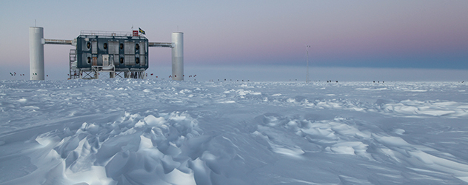
Our current neutrino effort is focused on realizing the full potential of the future DUNE neutrino oscillation experiment. DUNE will use an intense neutrino beam that will be sent from Fermilab (near Chicago) over 800 miles to a detector sited a mile underground in the Sanford Underground Research Facility in South Dakota. The experiment seeks to discover matter-antimatter asymmetries in neutrino flavor transitions, which may lead to a deeper understanding of the origin of the matter in our universe. DUNE also will determine the ordering of the neutrino masses, and test our current understanding that all neutrino oscillation phenomena originate form the known three types of neutrinos. The experiment will also be sensitive to neutrinos from supernovae and search for proton decay. In addition to applying our expertise in neutrino interactions to the experiment, we are working to realize the “near” detector for this experiment which measures the beam before oscillations (Profs Bodek, Manly, Marshall and McFarland).
The Rochester neutrino group is also involved in the current T2K (Tokai to Kamiokande) neutrino oscillations experiment at the Japanese Proton Accelerator Research Complex (J-PARC). T2K measures the probability that muon neutrinos oscillate to electron neutrinos as they propagate from Tokai to Kamiokande. In addition to paving the way for DUNE, T2K’s results provide a tantalizing hint of the matter-antimatter asymmetry described above (Profs. Manly and McFarland)
Underpinning these efforts is our work to measure and model neutrino quasielastic, inelastic and resonance production on nuclear targets, primarily with data from the MINERvA detector at the NUMI beam at Fermilab (Profs Bodek, Manly, McFarland). A complementary effort is the investigation of electron quasielastic, inelastic and resonance production on nuclear targets with the JUPITER experiment at Hall C at the Jefferson Laboratory (Profs. Bodek, Manly, and McFarland). These data, together with our efforts in phenomenological theory and modeling neutrino interactions, (Bodek) provide a detailed understanding of neutrino-nucleon interactions for neutrino oscillation experiments.
Learn more on our group page here.
PHYSICS AT HIGH ENERGY HADRON COLLIDERS
Our Energy Frontier group is engaged in analyzing data that represent the fruition of years of efforts toward construction of the Compact Muon Solenoid (CMS) detector at the Large Hadron Collider including studies of the heavy quarks, W and Z bosons, and searching for new physics
such as supersymmetry. The group is also actively engaged in upgrading the detector for the High Luminosity LHC era that will significantly extend the discovery potential and allow exploration of the Higgs sector to its fullest.
These studies are now ongoing at the CMS experiment at the Large Hadron Collider at CERN, again focusing on studies of the top quark, W and Z bosons, and investigation of the Higgs boson and search for supersymmetric particles (Profs. Bodek, Demina, Garcia-Bellido). The group played a major role in the construction of the CMS hadron calorimeter (Bodek) as well as the construction of the silicon tracker (Demina), and is now working on that upgrade.

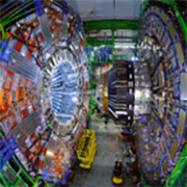
The Department has a long and distinguished history of research in the field of particle physics, which continues to the present.
Due to the rapid development of laser technology, electromagnetic fields with higher-and-higher intensity have become available, with the possibility of employing them to study still uncharted sectors of fundamental theories. Quantum Electrodynamics (QED) is certainly the best tested theory in terms of successful comparison of its predictions with experiments. Nevertheless, there are sectors of this theory, like the so-called strong-field one, which are not correspondingly thoroughly scrutinized. In the strong-field sector of QED, processes are studied which occur in the presence of intense background electromagnetic fields, which significantly alter the dynamics of charged particles like electrons and positrons. Processes which already occur in vacuum are strongly affected by the presence of the intense radiation and processes in intense lasers can also occur which are strictly forbidden in vacuum. For instance, in the collision of two sufficiently intense laser beams, avalanches of electrons, positrons and photons are expected to be generated out of pure light. Also, the vacuum in the presence of a strong laser beam is predicted to behave like a birefringent medium, with refractive indexes depending on the intensity of the background field. Finally, such pure quantum effects together with exotic classical phenomena like radiation reaction, i.e., the effect of the field produced by a charged particle onto the dynamics of the charge itself, are an important part of the programs of high-intensity laser facilities in Europe (ELI, APOLLON), Asia (SEL, CoReLS), and USA (ZEUS, SLAC), including the activities at the Laboratory for Laser Energetics (LLE) in Rochester. The programs of the above-mentioned facilities also include projects where lasers are employed to test physics beyond the Standard Model like the existence of axion and axion-like particles.

